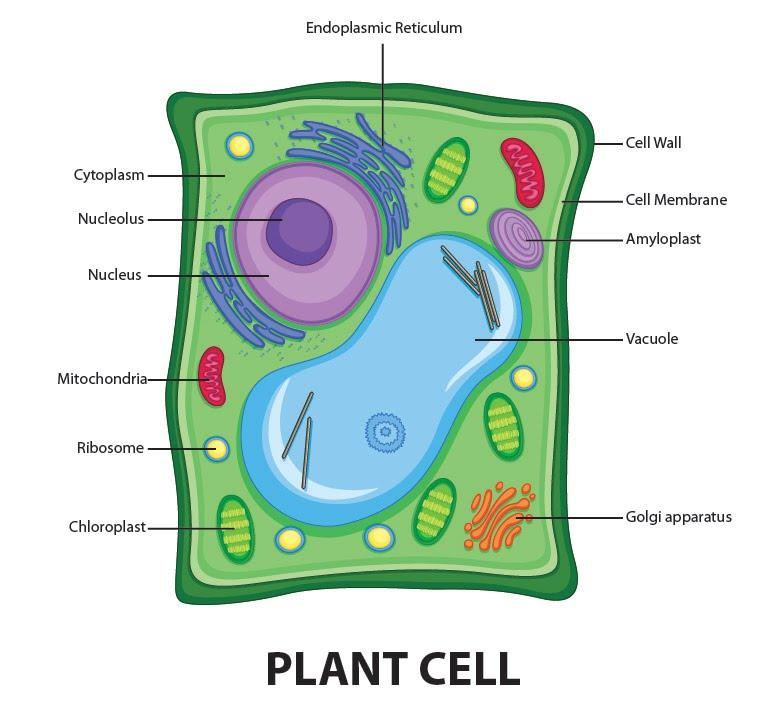
Draw a well-labelled diagram of a plant cell.
Answer
463.5k+ views
Hint: Plant cells are eukaryotic cells that change in several fundamental factors from other eukaryotic organisms. Both plant and animal cells contain nucleus alongside similar organelles. One among the distinctive aspects of a plant cell is the presence of a cell wall outside the cell membrane.
Complete step by step answer:
Plant cell structure includes various components referred to as cell organelles that perform different functions to sustain itself. These organelles include,

Cell Wall: It's a rigid layer which consists of cellulose, glycoproteins, lignin, pectin and hemicellulose. It’s located outside the cell wall. It comprises proteins, polysaccharides and cellulose.
Cell membrane: It's the semi-permeable membrane that's present within the cell wall. It’s composed of a skinny layer of protein and fat. The cell wall plays a crucial role in regulating the entry and exit of specific substances within the cell.
Nucleus: The nucleus is a membrane-bound structure that is present only in eukaryotic cells. The vital function of a nucleus is to store DNA or hereditary information required for cellular division, metabolism and growth.
Central Vacuole: It occupies around 30 percent of the cell’s volume during a mature plant cell. The vital function of central vacuole aside from storage is to sustain turgor pressure against the cell membrane. The central vacuole consists of cell sap. It’s a mix of salts, enzymes and other substances.
Golgi apparatus: they're found altogether in eukaryotic cells which are involved in distributing synthesized macromolecules to varied parts of the cell.
Ribosomes: they're the littlest membrane-bound organelles which comprise RNA and protein. They’re the sites for protein synthesis, hence, also mentioned because of the protein factories of the cell.
Mitochondria: they're the double-membrane organelles found within the cytoplasm of all eukaryotic cells. They supply energy by breaking down carbohydrate and sugar molecules, hence they're also mentioned because of the “Powerhouse of the cell.”
Lysosome: Lysosomes are called suicidal bags as they hold digestive enzymes in an indoor membrane. They perform the function of cellular waste disposal by digesting worn-out organelles, food particles and foreign bodies within the cell.
Note: Plant cells are the building blocks of plants. Photosynthesis is the major purpose performed by plant cells. Photosynthesis occurs within the chloroplasts of the plant cell. It’s the method of preparing food by the plants, by utilizing sunlight, carbon dioxide and water. Energy is produced within the sort of ATP within the process. A couple of plant cells help within the transport of water and nutrients from the roots and leaves to different parts of the plants.
Complete step by step answer:
Plant cell structure includes various components referred to as cell organelles that perform different functions to sustain itself. These organelles include,

Cell Wall: It's a rigid layer which consists of cellulose, glycoproteins, lignin, pectin and hemicellulose. It’s located outside the cell wall. It comprises proteins, polysaccharides and cellulose.
Cell membrane: It's the semi-permeable membrane that's present within the cell wall. It’s composed of a skinny layer of protein and fat. The cell wall plays a crucial role in regulating the entry and exit of specific substances within the cell.
Nucleus: The nucleus is a membrane-bound structure that is present only in eukaryotic cells. The vital function of a nucleus is to store DNA or hereditary information required for cellular division, metabolism and growth.
Central Vacuole: It occupies around 30 percent of the cell’s volume during a mature plant cell. The vital function of central vacuole aside from storage is to sustain turgor pressure against the cell membrane. The central vacuole consists of cell sap. It’s a mix of salts, enzymes and other substances.
Golgi apparatus: they're found altogether in eukaryotic cells which are involved in distributing synthesized macromolecules to varied parts of the cell.
Ribosomes: they're the littlest membrane-bound organelles which comprise RNA and protein. They’re the sites for protein synthesis, hence, also mentioned because of the protein factories of the cell.
Mitochondria: they're the double-membrane organelles found within the cytoplasm of all eukaryotic cells. They supply energy by breaking down carbohydrate and sugar molecules, hence they're also mentioned because of the “Powerhouse of the cell.”
Lysosome: Lysosomes are called suicidal bags as they hold digestive enzymes in an indoor membrane. They perform the function of cellular waste disposal by digesting worn-out organelles, food particles and foreign bodies within the cell.
Note: Plant cells are the building blocks of plants. Photosynthesis is the major purpose performed by plant cells. Photosynthesis occurs within the chloroplasts of the plant cell. It’s the method of preparing food by the plants, by utilizing sunlight, carbon dioxide and water. Energy is produced within the sort of ATP within the process. A couple of plant cells help within the transport of water and nutrients from the roots and leaves to different parts of the plants.
Recently Updated Pages
The correct geometry and hybridization for XeF4 are class 11 chemistry CBSE

Water softening by Clarks process uses ACalcium bicarbonate class 11 chemistry CBSE

With reference to graphite and diamond which of the class 11 chemistry CBSE

A certain household has consumed 250 units of energy class 11 physics CBSE

The lightest metal known is A beryllium B lithium C class 11 chemistry CBSE

What is the formula mass of the iodine molecule class 11 chemistry CBSE

Trending doubts
The reservoir of dam is called Govind Sagar A Jayakwadi class 11 social science CBSE

What problem did Carter face when he reached the mummy class 11 english CBSE

Proton was discovered by A Thomson B Rutherford C Chadwick class 11 chemistry CBSE

In China rose the flowers are A Zygomorphic epigynous class 11 biology CBSE

What is Environment class 11 chemistry CBSE

Nucleolus is present in which part of the cell class 11 biology CBSE




